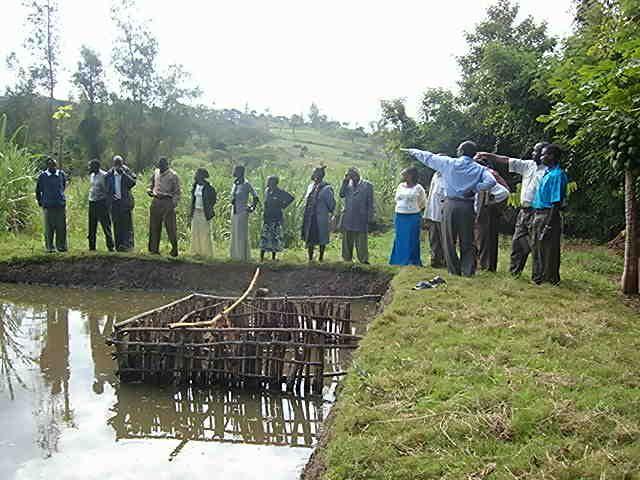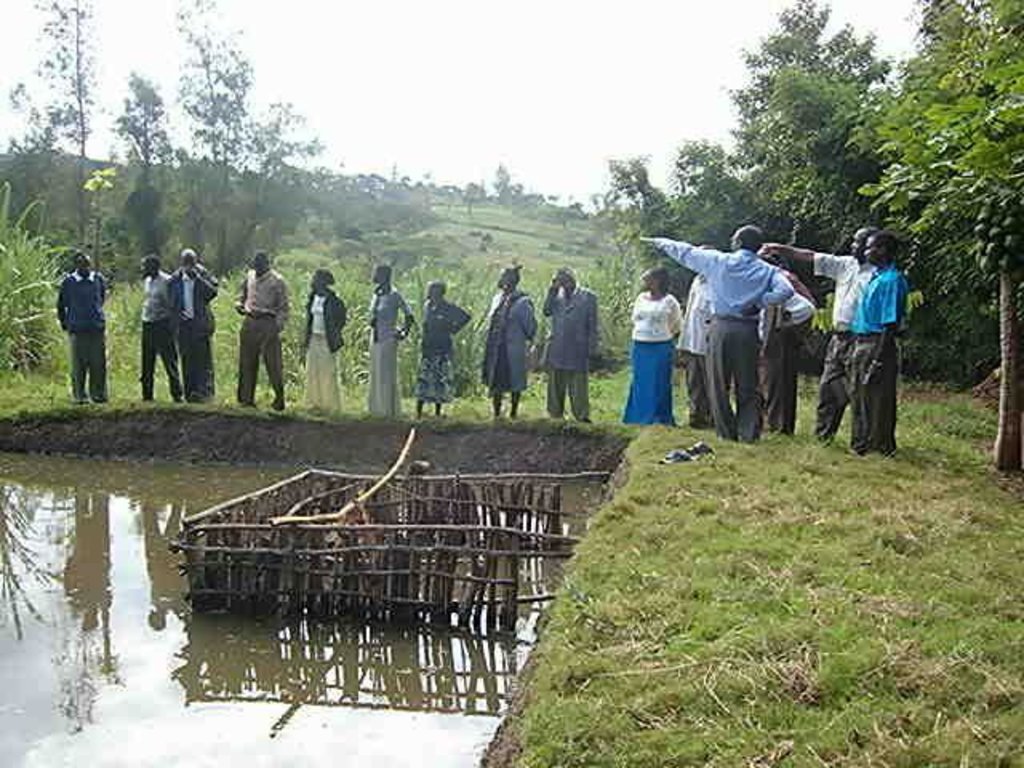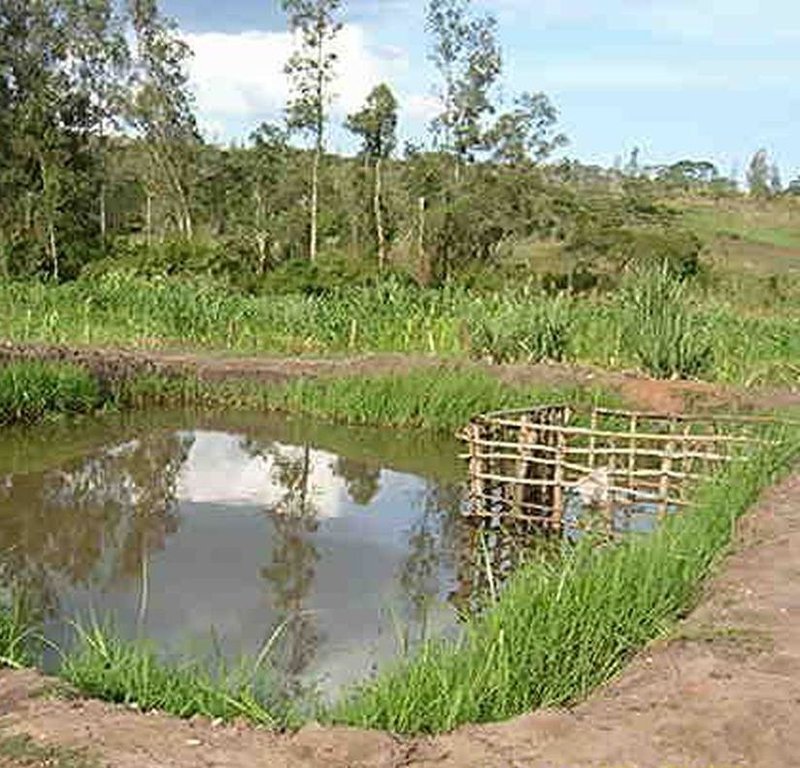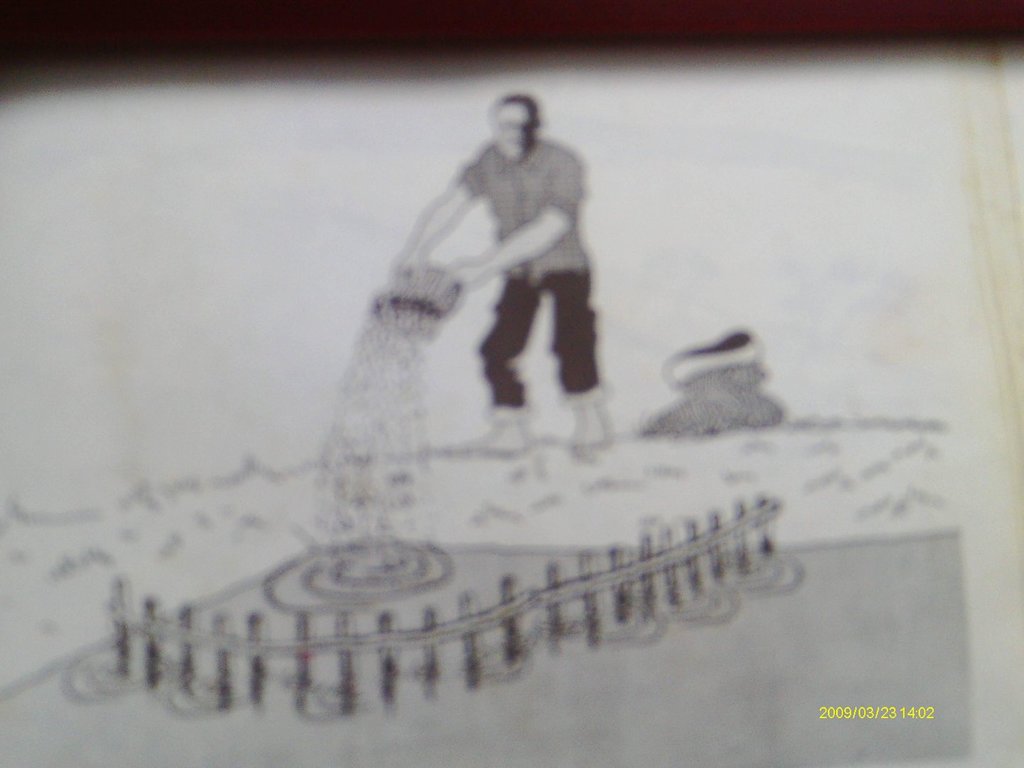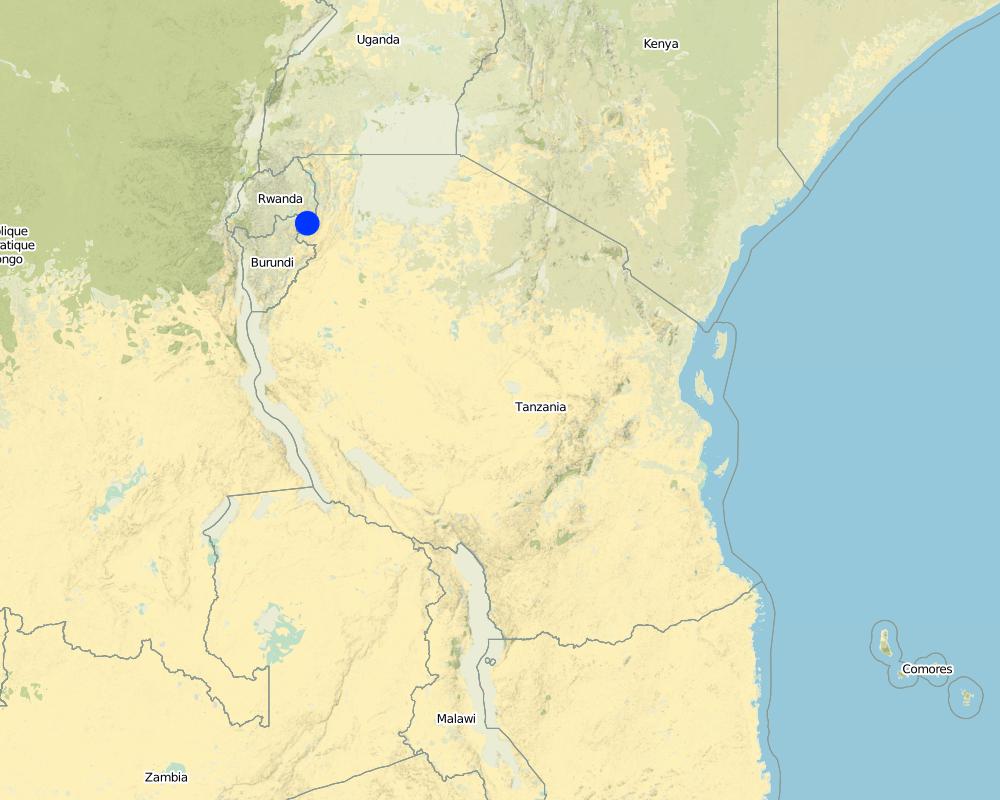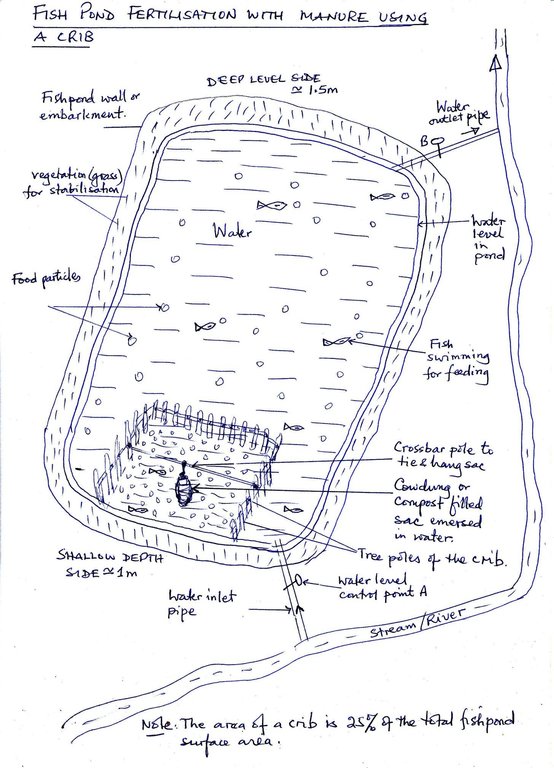FISH POND MANURING USING CRIB METHOD [แทนซาเนีย]
- ผู้สร้างสรรค์:
- การอัพเดท:
- ผู้รวบรวม: Philip Ileta
- ผู้เรียบเรียง: –
- ผู้ตรวจสอบ: David Streiff, Alexandra Gavilano
UFUGAJI WA SAMAKI KWENYE BWAWA
technologies_1154 - แทนซาเนีย
ดูส่วนย่อย
ขยายทั้งหมด ย่อทั้งหมด1. ข้อมูลทั่วไป
1.2 รายละเอียดที่ติดต่อได้ของผู้รวบรวมและองค์กรที่เกี่ยวข้องในการประเมินและการจัดเตรียมทำเอกสารของเทคโนโลยี
ผู้เชี่ยวชาญ SLM:
Zawadi Waziri
Enviroment Ngara
แทนซาเนีย
ผู้เชี่ยวชาญ SLM:
Mugishagwe Wilson
Forestry Ngara
แทนซาเนีย
ผู้เชี่ยวชาญ SLM:
Josephat Sangatati
Livestock Ngara
แทนซาเนีย
ชื่อขององค์กรซึ่งอำนวยความสะดวกในการทำเอกสารหรือการประเมินเทคโนโลยี (ถ้าเกี่ยวข้อง)
Ngara District Council (Ngara District Council) - แทนซาเนีย1.3 เงื่อนไขการใช้ข้อมูลที่ได้บันทึกผ่านทาง WOCAT
ผู้รวบรวมและวิทยากรหลักยอมรับเงื่อนไขเกี่ยวกับการใช้ข้อมูลที่ถูกบันทึกผ่านทาง WOCAT:
ใช่
2. การอธิบายลักษณะของเทคโนโลยี SLM
2.1 การอธิบายแบบสั้น ๆ ของเทคโนโลยี
คำจำกัดความของเทคโนโลยี:
This is a practice of fish farming whereby farmers excavate ponds ,fill in fresh water,stock-in fish fingerings and manage them to mature or marketable size
2.2 การอธิบายแบบละเอียดของเทคโนโลยี
คำอธิบาย:
Select a suitable area/site with permanent water source or alongside the flowing river/stream preferably with a clay soil and excavate a suitable sized pond(30mx20m)and a depth of 1,5-2m at the upper and lower side respectively. A crib of 4 m2 for application of manure is constructed using short tree poles at the shallow portion of the pond before filling in water and introducing fish fingerings
Purpose of the Technology: The crib provides an area where Farm yard manure or compost is put to decompose and thereby stimulate the growth of fish foods (phytoplanktons).
Establishment / maintenance activities and inputs: ESTABLISHMENT
-Selection of suitable area and pegging to required size/area
-Excavations to suitable depth
-Dig inlet canal from the water source through the shallow side and outlet canal from the deeper portion of the pond back to the main stream (Alternatively use small metal pipes,bamboo or plastic pipes for inlets and outlets)
-Compact the embankment and stabilize soil by planting suitable grass species such as vetiva spp etc
-Cut 2.5m long strong poles and construct a crib for manure application
-Spread manure at the bottom of the pond and wait for weeds growth (normally 2 weeks)
-Fill in water and stock in fingerings( 1 fingering per sq meter)
-Protect the pond by fencing preferably planting around live fence trees such as Dovyalis caffra,Pthecelobium dulce etc
MAINTANANCE
-Regular cleaning of the pond,and weeding the sorounding environment
-Feeeding with extra foods such as rice/maize brun,rice husks,chopped vegetables,pumpkins and potatoes etc
-Weekly application of farm yard manure or compost(1 tin 15-20 kg) by putting and tying by hanging a sac full in a crib.
-Shaking once daily the hanging sac while in water to release nutrients
Natural / human environment: The pond site should be easily accesible and where possible near homesteads for security purpose
-Harvesting may done by draining the water from the pond, using a seine net,and catch the desired size of fish while returning the young fish to continue growing
In good pond management/feeding farmers are able to harvest every after six months
2.3 รูปภาพของเทคโนโลยี
2.5 ประเทศภูมิภาค หรือสถานที่ตั้งที่เทคโนโลยีได้นำไปใช้และได้รับการครอบคลุมโดยการประเมินนี้
ประเทศ:
แทนซาเนีย
ภูมิภาค/รัฐ/จังหวัด:
Tanzania
ข้อมูลจำเพาะเพิ่มเติมของสถานที่ตั้ง :
Ngara District Council
ระบุการกระจายตัวของเทคโนโลยี:
- กระจายไปอย่างสม่ำเสมอในพื้นที่
If precise area is not known, indicate approximate area covered:
- < 0.1 ตร.กม.(10 เฮกตาร์)
แสดงความคิดเห็น:
Total area covered by the SLM Technology is 0.06 ha.
The group owns a fish pond of size 30mx20m in a wetland located in Kasulo village and is stocked with Tilapia spp fingerings
Map
×2.6 วันที่การดำเนินการ
ถ้าไม่รู้ปีที่แน่นอน ให้ระบุวันที่โดยประมาณ:
- 10-50 ปี
2.7 คำแนะนำของเทคโนโลยี
ให้ระบุว่าเทคโนโลยีถูกแนะนำเข้ามาอย่างไร:
- ทางโครงการหรือจากภายนอก
ความคิดเห็น (ประเภทของโครงการ เป็นต้น) :
fish farming in Ngara has been supported since the 1980s by UNICEF,DRDPS and recently by DANIDA through NGOs(REDESO and TCRS)
3. การจัดประเภทของเทคโนโลยี SLM
3.1 วัตถุประสงค์หลักของเทคโนโลยี
- ปรับปรุงการผลิตให้ดีขึ้น
- สร้างผลกระทบทางด้านเศรษฐกิจที่เป็นประโยชน์
3.2 ประเภทของการใช้ที่ดินในปัจจุบันที่ได้นำเทคโนโลยีไปใช้

ทางน้ำ แหล่งน้ำ พื้นที่ชุ่มน้ำ
- บ่อน้ำ เขื่อน
แสดงความคิดเห็น:
Major land use problems (compiler’s opinion): -less utilisation of wetlands resources to contribute in improving (livelihood) nutrition and groups/huosehold income
-some fish species (larvifish)may be stocked in ponds to feed on diseases vectors such as mosquitoe larva and reduce malaria incidences
Major land use problems (land users’ perception): To obtain fish for food and surplus harvest for income
Type of cropping system and major crops comments: farmers cultivate small plots of vegetables,sweet potatoes in valleys near fish ponds and chop them to supplement fish meals
3.4 การใช้น้ำ
แสดงความคิดเห็น:
Number of growing seasons per year:
2
Specify:
Longest growing period in days: 120; Longest growing period from month to month: October to January; Second longest growing period in days: 90; Second longest growing period from month to month: March to May
3.5 กลุ่ม SLM ที่ตรงกับเทคโนโลยีนี้
- การเลี้ยงผึ้ง การเพาะเลี้ยงสัตว์น้ำ สัตว์ปีก ฟาร์มกระต่าย ฟาร์มหนอนไหม
3.6 มาตรการ SLM ที่ประกอบกันเป็นเทคโนโลยี

มาตรการจัดการพืช
- A6: Residue management
- A7: Others

มาตรการอนุรักษ์ด้วยวิธีพืช
- V5: อื่นๆ

มาตรการอนุรักษ์ด้วยโครงสร้าง
- S5: เขื่อน ชั้นดินที่แน่นแข็งบ่อน้ำ

มาตรการอนุรักษ์ด้วยการจัดการ
- M5: การควบคุมหรือการเปลี่ยนแปลงขององค์ประกอบของชนิดพันธุ์
แสดงความคิดเห็น:
Secondary measures: management measures
Specification of other agronomic measures: water storage for fish culture
Type of agronomic measures: manure / compost / residues
Type of vegetative measures: scattered / dispersed
3.7 รูปแบบหลักของการเสื่อมโทรมของที่ดินที่ได้รับการแก้ไขโดยเทคโนโลยี

การเสื่อมโทรมของดินทางด้านชีวภาพ
- Bh (Loss of habitat): การสูญเสียแหล่งที่อยู่
แสดงความคิดเห็น:
Secondary types of degradation addressed: Bh: loss of habitats
Main causes of degradation: other human induced causes (specify) (over exploitation of fish in natural water bodies)
Secondary causes of degradation: Heavy / extreme rainfall (intensity/amounts) (Causing siltation,flooding of already constructed fish ponds), other natural causes (avalanches, volcanic eruptions, mud flows, highly susceptible natural resources, extreme topography, etc.) specify (blocking of water channels, ponds due to mud)
3.8 การป้องกัน การลดลง หรือการฟื้นฟูความเสื่อมโทรมของที่ดิน
ระบุเป้าหมายของเทคโนโลยีกับความเสื่อมโทรมของที่ดิน:
- ป้องกันความเสื่อมโทรมของที่ดิน
4. ข้อมูลจำเพาะด้านเทคนิค กิจกรรมการนำไปปฏิบัติใช้ ปัจจัยนำเข้า และค่าใช้จ่าย
4.1 แบบแปลนทางเทคนิคของเทคโนโลยี
ข้อมูลจำเพาะด้านเทคนิค (แบบแปลนทางเทคนิคของเทคโนโลยี):
Fish pond fertilization with manure using a crib
Location: yyy village. Ngara District Council/Tanzania
Date: 15 May 2012
Technical knowledge required for field staff / advisors: moderate (Once the fishpond is established,the extension kit requires regular monitoring for improvement of fish feeds and outbreak of diseases which are relatively few compared to other livestocks such as pok)
Technical knowledge required for land users: moderate (Following the fish pond manual developed by the district is simple with regard to pond management and feeding regimes)
Main technical functions: increase in nutrient availability (supply, recycling,…)
Secondary technical functions: increase in organic matter, promotion of vegetation species and varieties (quality, eg palatable fodder)
Manure / compost / residues
Material/ species: cowdung
Quantity/ density: 50 kgs
Remarks: applied in crib once weekly per pond
Scattered / dispersed
Vegetative material: G : grass
Number of plants per (ha): 300
Vertical interval between rows / strips / blocks (m): seedlings
Vertical interval within rows / strips / blocks (m): 0.1
Width within rows / strips / blocks (m): 0.1
Grass species: vetiva planted to stablise pond embarkments
Dam/ pan/ pond
Depth of ditches/pits/dams (m): 1.5
Width of ditches/pits/dams (m): 20
Length of ditches/pits/dams (m): 30
Reshaping surface
Length of ditches/pits/dams (m): 2
Construction material (earth): The pond has the deeper side 1.5m and shallower side 1.0m,with the top earth compacted 2m wide
Vegetation is used for stabilisation of structures.
Change of land use practices / intensity level: Wetlands were marginally used only for dry season agriculture and some vegatable growing-now aquaculture intergration adding productive value to it
Control / change of species composition: Most farmers preferered Tilapia nilotica for stocking in fishponds,phytoplanktons growth promoted
ผู้เขียน:
Ileta Philip, c/o DED Ngara District Council
4.2 ข้อมูลทั่วไปเกี่ยวกับการคำนวณปัจจัยนำเข้าและค่าใช้จ่าย
ให้ระบุว่าค่าใช้จ่ายและปัจจัยนำเข้าได้รับการคำนวณอย่างไร:
- ต่อหน่วยเทคโนโลยี
โปรดระบุหน่วย:
Fishpond
Specify dimensions of unit (if relevant):
30m x 20m
อื่นๆ หรือสกุลเงินประจำชาติ (ระบุ):
Tanzania shilling
If relevant, indicate exchange rate from USD to local currency (e.g. 1 USD = 79.9 Brazilian Real): 1 USD =:
1600.0
ระบุค่าเฉลี่ยของค่าจ้างในการจ้างแรงงานต่อวัน:
1.25
4.3 กิจกรรมเพื่อการจัดตั้ง
| กิจกรรม | Timing (season) | |
|---|---|---|
| 1. | Buying of vetiva | during the rains |
| 2. | Planting of vetiva on embarkments | during rains |
| 3. | Allignment and layout of pond | before rains |
| 4. | Excavation of the pond | before rains |
| 5. | Raising embarkments,compaction construction inlets and outlets | before rains |
| 6. | Collect cow dung | |
| 7. | Purchase fish fingerings | |
| 8. | Purchase tools |
แสดงความคิดเห็น:
Lifespan of dung, fish fingerings and tools: 3 years
4.4 ค่าใช้จ่ายของปัจจัยนำเข้าที่จำเป็นสำหรับการจัดตั้ง
| ปัจจัยนำเข้า | หน่วย | ปริมาณ | ค่าใช้จ่ายต่อหน่วย | ค่าใช้จ่ายทั้งหมดต่อปัจจัยนำเข้า | %ของค่าใช้จ่ายที่ก่อให้เกิดขึ้นโดยผู้ใช้ที่ดิน | |
|---|---|---|---|---|---|---|
| แรงงาน | Planting of vetiva on embarkments | persons/day | 2.0 | 1.25 | 2.5 | 100.0 |
| แรงงาน | Allignment and layout of pond | persons/day | 2.0 | 1.25 | 2.5 | 50.0 |
| แรงงาน | Excavation of the pond | persons/day | 120.0 | 1.88 | 225.6 | 100.0 |
| แรงงาน | Raising embarkments,compaction construction inlets and outlets | persons/day | 3.0 | 1.25 | 3.75 | 100.0 |
| อุปกรณ์ | Fish fingerings | pieces | 1000.0 | 0.06 | 60.0 | 20.0 |
| อุปกรณ์ | Tools | pieces | 4.0 | 12.5 | 50.0 | 20.0 |
| อุปกรณ์ | Vetiva | pieces | 300.0 | 0.16666 | 50.0 | 100.0 |
| ปุ๋ยและสารฆ่า/ยับยั้งการเจริญเติบโตของสิ่งมีชีวิต (ไบโอไซด์) | Cowdung | kg | 50.0 | 1.25 | 62.5 | 100.0 |
| ค่าใช้จ่ายทั้งหมดของการจัดตั้งเทคโนโลยี | 456.85 | |||||
| Total costs for establishment of the Technology in USD | 0.29 | |||||
แสดงความคิดเห็น:
Duration of establishment phase: 4 month(s)
4.5 การบำรุงรักษาสภาพหรือกิจกรรมที่เกิดขึ้นเป็นประจำ
| กิจกรรม | ช่วงระยะเวลา/ความถี่ | |
|---|---|---|
| 1. | Application of cowdung | weekly |
| 2. | Application of extra feeds | fortnight |
| 3. | Clean weeding | monthly |
| 4. | Trimming the live fence,weeding and monitoring | dry seson |
| 5. | Repairing of walls | after heavy storms |
| 6. | Management of fingerings -monitoring of growth,control of overpopulation | monthly |
| 7. | Cowdung application and manipulation for nutrients release | weekly |
4.6 ค่าใช้จ่ายของปัจจัยนำเข้าและกิจกรรมที่เกิดขึ้นเป็นประจำที่ต้องการการบำรุงรักษา (ต่อปี)
| ปัจจัยนำเข้า | หน่วย | ปริมาณ | ค่าใช้จ่ายต่อหน่วย | ค่าใช้จ่ายทั้งหมดต่อปัจจัยนำเข้า | %ของค่าใช้จ่ายที่ก่อให้เกิดขึ้นโดยผู้ใช้ที่ดิน | |
|---|---|---|---|---|---|---|
| แรงงาน | Clean weeding | persons/day | 2.0 | 1.25 | 2.5 | 100.0 |
| แรงงาน | Trimming the live fence,weeding and monitoring | persons/day | 2.0 | 1.25 | 2.5 | 100.0 |
| แรงงาน | Repairing of walls | persons/day | 2.0 | 1.25 | 2.5 | 100.0 |
| แรงงาน | Management of fingerings | persons/day | 4.0 | 1.6 | 6.4 | 100.0 |
| อุปกรณ์ | Extra feeds (maize and ricebran) | kg | 10.0 | 1.88 | 18.8 | 100.0 |
| ปุ๋ยและสารฆ่า/ยับยั้งการเจริญเติบโตของสิ่งมีชีวิต (ไบโอไซด์) | Cowdung | kg | 50.0 | 1.25 | 62.5 | 100.0 |
| อื่น ๆ | Labour: Cowdung application and manipulation for nutrients release | persons/day | 1.0 | 1.25 | 1.25 | 100.0 |
| ค่าใช้จ่ายทั้งหมดของการบำรุงรักษาสภาพเทคโนโลยี | 96.45 | |||||
| Total costs for maintenance of the Technology in USD | 0.06 | |||||
แสดงความคิดเห็น:
the costs are calculated per fish pond of size 20m width,30m length and depth 1.5m
4.7 ปัจจัยสำคัญที่สุดที่มีผลกระทบต่อค่าใช้จ่าย
ปัจจัยสำคัญที่สุดที่มีผลกระทบต่อค่าใช้จ่ายต่างๆ:
labour especially during excavations(establishment phase)
cowdung when the land user buys instead of obtaining from the homestead/kraal
5. สิ่งแวดล้อมทางธรรมชาติและของมนุษย์
5.1 ภูมิอากาศ
ฝนประจำปี
- < 250 ม.ม.
- 251-500 ม.ม.
- 501-750 ม.ม.
- 751-1,000 ม.ม.
- 1,001-1,500 ม.ม.
- 1,501-2,000 ม.ม.
- 2,001-3,000 ม.ม.
- 3,001-4,000 ม.ม.
- > 4,000 ม.ม.
ระบุปริมาณน้ำฝนเฉลี่ยรายปี (ถ้ารู้) :หน่วย ม.ม.
950.00
ข้อมูลจำเพาะ/ความคิดเห็นเรื่องปริมาณน้ำฝน:
Length of dry periods 4 months
Main rain season Oct to Dec/January, Second season March to Mid May
เขตภูมิอากาศเกษตร
- กึ่งชุ่มชื้น
Thermal climate class: tropics. Hot during the days slighly cold nights,avarage temp range18-30C
5.2 สภาพภูมิประเทศ
ค่าเฉลี่ยความลาดชัน:
- ราบเรียบ (0-2%)
- ลาดที่ไม่ชัน (3-5%)
- ปานกลาง (6-10%)
- เป็นลูกคลื่น (11-15%)
- เป็นเนิน (16-30%)
- ชัน (31-60%)
- ชันมาก (>60%)
ธรณีสัณฐาน:
- ที่ราบสูง/ที่ราบ
- สันเขา
- ไหล่เขา
- ไหล่เนินเขา
- ตีนเนิน
- หุบเขา
ระดับความสูง:
- 0-100 เมตร
- 101-500 เมตร
- 501-1,000 เมตร
- 1,001-1,500 เมตร
- 1,501-2,000 เมตร
- 2,001-2,500 เมตร
- 2,501-3,000 เมตร
- 3,001-4,000 เมตร
- > 4,000 เมตร
ให้ระบุถ้าเทคโนโลยีได้ถูกนำไปใช้:
- บริเวณแอ่งบนที่ราบ (concave situations)
5.3 ดิน
ค่าเฉลี่ยความลึกของดิน:
- ตื้นมาก (0-20 ซ.ม.)
- ตื้น (21-50 ซ.ม.)
- ลึกปานกลาง (51-80 ซ.ม.)
- ลึก (81-120 ซ.ม.)
- ลึกมาก (>120 ซ.ม.)
เนื้อดิน (ดินชั้นบน):
- ปานกลาง (ดินร่วน ทรายแป้ง)
- ละเอียด/หนัก (ดินเหนียว)
อินทรียวัตถุในดิน:
- สูง (>3%)
- ปานกลาง (1-3%)
(ถ้ามี) ให้แนบคำอธิบายเรื่องดินแบบเต็มหรือระบุข้อมูลที่มีอยู่ เช่น ชนิดของดิน ค่า pH ของดินหรือความเป็นกรดของดิน ความสามารถในการแลกเปลี่ยนประจุบวก ไนโตรเจน ความเค็ม เป็นต้น:
Soil depth on average: Shallow (ranked 1, loamy to heavy clayey basement) and moderately deep (ranked 2)
Soil fertility: Medium (ranked 1), low (ranked 2) and high (ranked 3)
Topsoil organic matter is medium (ranked 1) and high (ranked 2)
Soil drainage / infiltration is poor and retains water in pond permanently, but medium in severe dry spell and water level decrease to half pond depth.
Soil water storage capacity is high near wetlands and permanent streams. Sometimes also very high
5.4 ความเป็นประโยชน์และคุณภาพของน้ำ
ระดับน้ำใต้ดิน:
ที่ผิวดิน
น้ำไหลบ่าที่ผิวดิน:
ดี
คุณภาพน้ำ (ที่ยังไม่ได้บำบัด):
เป็นน้ำใช้เพื่อการเกษตรเท่านั้น (การชลประทาน)
ความคิดเห็นและข้อมูลจำเพาะเพิ่มเติมเรื่องคุณภาพและปริมาณน้ำ:
Availability of surface water: Good (ranked 1) and excess (ranked 2, the site of the pond is located such that at maximum flooding it shoul d not be reached by flood water to prevent fish escape/overflow)
Water quality (untreated): For agricultural use only: Wetlands used for dry season farming and small horticultural gardens. Farmers fetch water in the streams due to unavailability of safe water points
5.5 ความหลากหลายทางชีวภาพ
ความหลากหลายทางชนิดพันธุ์:
- ต่ำ
ความคิดเห็นและข้อมูลจำเพาะเพิ่มเติมของความหลากหลายทางชีวภาพ:
Decreasing rapidly due to pollution of water sources, deforeatstion and overexploiation of natural fish stocks
5.6 ลักษณะของผู้ใช้ที่ดินที่นำเทคโนโลยีไปปฏิบัติใช้
แนวทางการตลาดของระบบการผลิต:
- เพื่อการยังชีพ (หาเลี้ยงตนเอง)
- mixed (subsistence/ commercial)
รายได้ที่มาจากนอกฟาร์ม:
- > 50% ของรายได้ทั้งหมด
ระดับของความมั่งคั่งโดยเปรียบเทียบ:
- จน
- พอมีพอกิน
เป็นรายบุคคล/ครัวเรือน:
- กลุ่ม/ชุมชน
ระดับของการใช้เครื่องจักรกล:
- งานที่ใช้แรงกาย
เพศ:
- หญิง
- ชาย
ระบุลักษณะอื่นๆที่เกี่ยวข้องของผู้ใช้ที่ดิน:
Difference in the involvement of women and men: Excavations usually by men labour but for maintanance activitiies women play increasing roles
Population density: 10-50 persons/km2
60% of the land users are average wealthy.
20% of the land users are poor.
Off-farm income specification: Most of the farmers with ponds have livestock and apply cow dung instaed of compost
Market orientation of production system: Mixed (farmers sell some surplus fish although productivity still below avarage)
5.7 Average area of land used by land users applying the Technology
- < 0.5 เฮกตาร์
- 0.5-1 เฮกตาร์
- 1-2 เฮกตาร์
- 2-5 เฮกตาร์
- 5-15 เฮกตาร์
- 15-50 เฮกตาร์
- 50-100 เฮกตาร์
- 100-500 เฮกตาร์
- 500-1,000 เฮกตาร์
- 1,000-10,000 เฮกตาร์
- >10,000 เฮกตาร์
พิจารณาว่าเป็นขนาดเล็ก กลาง หรือขนาดใหญ่ (ซึ่งอ้างอิงถึงบริบทระดับท้องถิ่น):
- ขนาดเล็ก
5.8 กรรมสิทธิ์ในที่ดิน สิทธิในการใช้ที่ดินและสิทธิในการใช้น้ำ
กรรมสิทธิ์ในที่ดิน:
- เป็นแบบชุมชนหรือหมู่บ้าน
- กลุ่ม
สิทธิในการใช้ที่ดิน:
- เกี่ยวกับชุมชน (ถูกจัดระเบียบ)
สิทธิในการใช้น้ำ:
- เข้าถึงได้แบบเปิด (ไม่ได้จัดระเบียบ)
แสดงความคิดเห็น:
water use is free for use by all community members especially for agricultural activities
5.9 การเข้าถึงบริการและโครงสร้างพื้นฐาน
สุขภาพ:
- จน
- ปานกลาง
- ดี
การศึกษา:
- จน
- ปานกลาง
- ดี
ความช่วยเหลือทางด้านเทคนิค:
- จน
- ปานกลาง
- ดี
การจ้างงาน (เช่น ภายนอกฟาร์ม):
- จน
- ปานกลาง
- ดี
ตลาด:
- จน
- ปานกลาง
- ดี
พลังงาน:
- จน
- ปานกลาง
- ดี
ถนนและการขนส่ง:
- จน
- ปานกลาง
- ดี
น้ำดื่มและการสุขาภิบาล:
- จน
- ปานกลาง
- ดี
บริการด้านการเงิน:
- จน
- ปานกลาง
- ดี
6. ผลกระทบและสรุปคำบอกกล่าว
6.1 ผลกระทบในพื้นที่ดำเนินการ (On-site) จากการใช้เทคโนโลยี
ผลกระทบทางด้านเศรษฐกิจและสังคม
การผลิต
การผลิตพืชที่ใช้เลี้ยงปศุสัตว์
แสดงความคิดเห็น/ระบุ:
Phytoplanktons feeds
พื้นที่สำหรับการผลิต
จำนวนก่อน SLM:
0
หลังจาก SLM:
0.06
แสดงความคิดเห็น/ระบุ:
This is the surface area of the pond
รายได้และค่าใช้จ่าย
รายได้จากฟาร์ม
จำนวนก่อน SLM:
100
หลังจาก SLM:
375
แสดงความคิดเห็น/ระบุ:
Market for fish is available when good size
ผลกระทบด้านสังคมวัฒนธรรมอื่น ๆ
ความมั่นคงด้านอาหาร / พึ่งตนเองได้
แสดงความคิดเห็น/ระบุ:
From increased income
สถานการณ์ด้านสุขภาพ
แสดงความคิดเห็น/ระบุ:
Animal protein source menu, but malaria and bilhazia vectors when ponds are not well kept/managed
livelihood and human well-being
แสดงความคิดเห็น/ระบุ:
When the suitable species of fish is stocked and proper fish pond management procedures adhered to -the harvest are high-at least once to twice per year-but this requires high initial and maintanance capital -routine extension from aquaculture experts is highly needed to enable farmers realise profits
ผลกระทบด้านนิเวศวิทยา
ดิน
อินทรียวัตถุในดิน/ต่ำกว่าดินชั้น C
แสดงความคิดเห็น/ระบุ:
From decomposition of cow dung
ความหลากหลายทางชีวภาพของพืชและสัตว์
ความหลากหลายทางชีวภาพของพืช
แสดงความคิดเห็น/ระบุ:
Phytoplanktons and water weeds
ความหลากหลายของสัตว์
แสดงความคิดเห็น/ระบุ:
Other water fauna and flora which are not predators may be allowed to flourish
6.2 ผลกระทบนอกพื้นที่ดำเนินการ (Off-site) จากการใช้เทคโนโลยี
น้ำท่วมพื้นที่ท้ายน้ำ
แสดงความคิดเห็น/ระบุ:
Water retained in ponds when adopted farmers increase
6.3 การเผชิญและความตอบสนองของเทคโนโลยีต่อการเปลี่ยนแปลงสภาพภูมิอากาศที่ค่อยเป็นค่อยไป และสภาพรุนแรงของภูมิอากาศ / ภัยพิบัติ (ที่รับรู้ได้โดยผู้ใช้ที่ดิน)
การเปลี่ยนแปลงสภาพภูมิอากาศที่ค่อยเป็นค่อยไป
การเปลี่ยนแปลงสภาพภูมิอากาศที่ค่อยเป็นค่อยไป
| ฤดู | increase or decrease | เทคโนโลยีมีวิธีการรับมืออย่างไร | |
|---|---|---|---|
| อุณหภูมิประจำปี | เพิ่มขึ้น | ไม่ค่อยดี |
สภาพรุนแรงของภูมิอากาศ (ภัยพิบัติ)
ภัยพิบัติจากสภาพภูมิอากาศ
| เทคโนโลยีมีวิธีการรับมืออย่างไร | |
|---|---|
| ภัยจากฝนแล้ง | ไม่ค่อยดี |
ภัยพิบัติจากน้ำ
| เทคโนโลยีมีวิธีการรับมืออย่างไร | |
|---|---|
| น้ำท่วมตามปกติ (แม่น้ำ) | ไม่ค่อยดี |
แสดงความคิดเห็น:
The productivity of the fish pond is determined by many factors including the selected species of fish,the feeding levels and the temperature of water. Most tropical fish species grows well when the temperature of the pond water remains warm
6.4 การวิเคราะห์ค่าใช้จ่ายและผลประโยชน์ที่ได้รับ
ผลประโยชน์ที่ได้รับเปรียบเทียบกับค่าใช้จ่ายในการจัดตั้งเป็นอย่างไร (จากมุมมองของผู้ใช้ที่ดิน)
ผลตอบแทนระยะสั้น:
ด้านบวก
ผลตอบแทนระยะยาว:
ด้านบวก
ผลประโยชน์ที่ได้รับเปรียบเทียบกับค่าใช้จ่ายในการบำรุงรักษาหรือต้นทุนที่เกิดขึ้นซ้ำอีก เป็นอย่างไร (จากมุมมองของผู้ใช้ที่ดิน)
ผลตอบแทนระยะสั้น:
ด้านบวก
ผลตอบแทนระยะยาว:
ด้านบวก
แสดงความคิดเห็น:
Initial establishment capital high
Cow dung may be obtained free from kraal or altenative use compost
manure
6.5 การปรับตัวของเทคโนโลยี
- ครั้งเดียวหรือเป็นการทดลอง
ถ้ามีข้อมูลให้บอกปริมาณด้วย (จำนวนของครัวเรือนหรือครอบคลุมพื้นที่):
3 households
Of all those who have adopted the Technology, how many did so spontaneously, i.e. without receiving any material incentives/ payments?
- 0-10%
แสดงความคิดเห็น:
3 land user families have adopted the Technology with external material support
Comments on acceptance with external material support: The fish ponds project attracted many families to engage in the activities,the constraints were high capital investments and poor pond managent
There is a little trend towards spontaneous adoption of the Technology
Comments on adoption trend: especially for well off farmers with land holdings near wetlands and streams
6.7 จุดแข็ง / ข้อได้เปรียบ / โอกาสของเทคโนโลยี
| จุดแข็ง / ข้อได้เปรียบ / โอกาสในทัศนคติของผู้ใช้ที่ดิน |
|---|
|
Availability of permanent water sources especially streams How can they be sustained / enhanced? Conservation bylaws enforced on bufferzones |
| จุดแข็ง / ข้อได้เปรียบ / โอกาสในทัศนคติของผู้รวบรวมหรือวิทยากรหลัก |
|---|
|
Availability of permanent water sources especially streams How can they be sustained / enhanced? Conservation bylaws enforced on bufferzones |
|
Farmers owns cattle/shorts How can they be sustained / enhanced? Enhance crop and livestock intergration |
|
Wetlands are owned comunally and by village governments How can they be sustained / enhanced? Bylaws enforcement to prevent encroachment and pollution |
6.8 จุดอ่อน / ข้อเสียเปรียบ / ความเสี่ยงของเทคโนโลยีและวิธีการแก้ไข
| จุดอ่อน / ข้อเสียเปรียบ / ความเสี่ยงในทัศนคติของผู้ใช้ที่ดิน | มีวิธีการแก้ไขได้อย่างไร |
|---|---|
| High capital investments | Family oriented groups have some success ,to think of some subsidies throgh government or simple credit schemes |
| จุดอ่อน / ข้อเสียเปรียบ / ความเสี่ยงในทัศนคติของผู้รวบรวมหรือวิทยากรหลัก | มีวิธีการแก้ไขได้อย่างไร |
|---|---|
| High capital investments | Group approach used -although many groups fail to sustain the ponds |
ลิงก์และโมดูล
ขยายทั้งหมด ย่อทั้งหมดลิงก์
ไม่มีลิงก์
โมดูล
ไม่มีโมดูล


